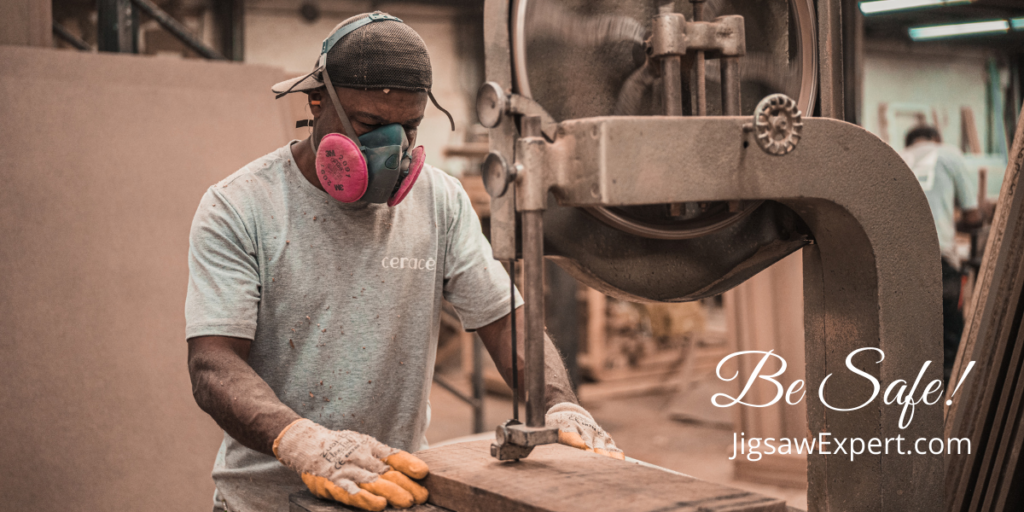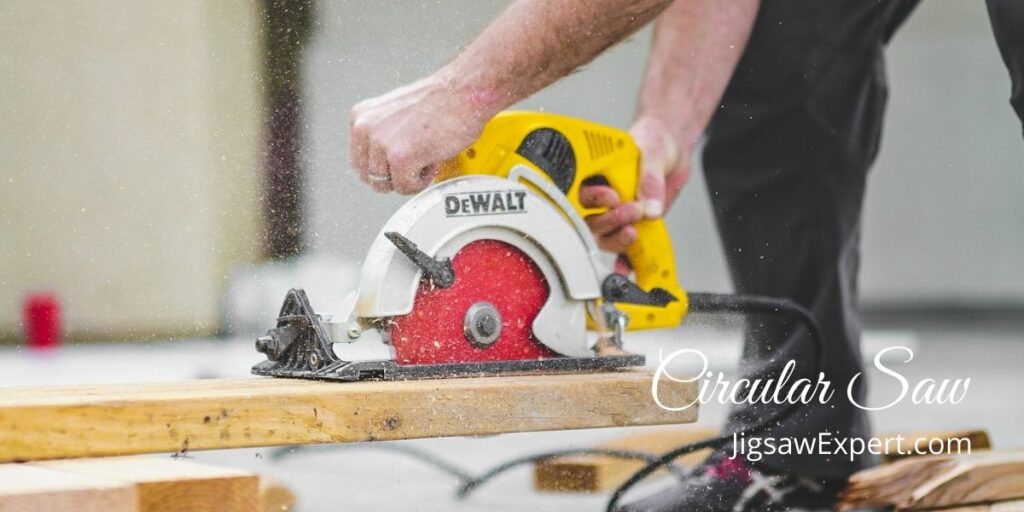Woodworking safety is a serious issue. Regardless of whether you are a hobbyist or a professional, keeping yourself and your tools safe is the top priority. If something falls, if your machine starts to kick up sawdust, or if any other unexpected event occurs, someone in your vicinity could get hurt.
Woodworking has been around for centuries, and there are many different ways to craft a piece. But one thing they all have in common is the need for safety precautions. From choosing the right tools to knowing which cuts you can make with what blade or saw, woodworkers must know about their workspace and how to keep themselves safe while they work on it.
You should be as careful while woodworking as you are when driving a car. You have to drive defensively and keep yourself safe and others around you safe. You should not allow yourself to work carelessly with your woodworking tools or in your workshop.
Your workshop should also follow specific safety rules. Most workshops will have saws, sanders, drills, etc. — and each of these has its own safety precautions. Know what you are working with, learn the proper way to handle it, keep yourself safe at all times, and always be aware of your surroundings while you work.
Below is a list of some situations where woodworkers can get hurt or damage their workspace if they do not take the proper precautions. Read over them, learn the facts, make yourself aware of what can happen if you are not careful with your tools and your workspace. Then enjoy working safely:
- 1. Always Wear Safety Gears
- 2. Work in a well lit area
- 3. Always wear the proper clothing
- 4. Don't wear jewelry
- 5. Disconnect Power When Changing Blades OR Bits.
- 6. Don't use drugs or alcohol while working
- 7. Use sharp blades and bits
- 8. Work against the cutter blade, not with it!
- 9. Always use a single extension cord
- 10. Never reach over a running blade
- 11. Always secure your workpiece
- 12. Ask for help when needed
- 13. Never Work While Tired
- 14. Minimize Distractions
- 15. Always work with a partner
- 16. Check Wood for Nails While Walking OR Handling
- 17. Always Work from a Stable Platform
- 18. Read Your Tools Manual First
- 19. Always Clean Your Sawdust After Work
- 20. Cut Off the Power When Freeing Stalled Blade
- 21. Always keep fire extinguisher and first aid kit in your Workshop
- 22. Allow room around slippery items
- 23. Remember to stay away from electrical circuits and moving machinery
- 24. Use Push Sticks OR Pads When Using Saws
- 25. Always Maintain Your Tools
- 26. Train Yourself First From A Professional
- 27. Learn to Use Your BRAIN First
- Conclusion
BTW, check our other posts about
- Best jigsaw for woodworking
- Best miter saw on the market
- Best jigsaw on the market
1. Always Wear Safety Gears

Even when you are just picking up your tools to start a project or shift your position, never work without wearing your protective glasses. Glasses will help protect against flying debris and other potential hazards.
If you don’t wear safety glasses while working with power tools such as drills and sanders, you should wear goggles. Goggles are made specifically for this type of activity and will protect your eyes better than safety glasses.
2. Work in a well lit area
Working in a poorly lit area can be very dangerous. If you have poor vision already, or if the lighting is not bright enough so that you won’t accidentally lose track of what you are working on, you could accidentally cut something or damage your workpiece.
3. Always wear the proper clothing
Never work without wearing the proper clothes and safety gear. If you have long hair that can tangle in a drill bit, tie it up. Wear closed-toed shoes as well (this applies to both men and women). You should also wear gloves to protect your hands.
4. Don’t wear jewelry

No matter how tempted you are, never wear jewelry. You never know when your jewelry is going to get caught on a blade or saw.
If you have jewelry on your hand, it may caught in a miter saw blade or jigsaw blade.
5. Disconnect Power When Changing Blades OR Bits.
If you are going to change blades or bits on a power tool, first disconnect the power. You may accidentally lose your fingers. Also, be sure that you switch off of any anti-kickback devices when using a bit, otherwise, if the product grabs at the blade, you could lose control of your tool.
6. Don’t use drugs or alcohol while working
While some woodworkers are passionate about what they do, that does not mean that their passion should take over their ability to stay sober and alert. If a project has taken all day and you have been drinking throughout the process, it is best to break and come back to your work safely tomorrow.
It is only a matter of time until you end up cutting into yourself with a saw or drill, and no one wants it to be their blood on the floor tomorrow.
7. Use sharp blades and bits
Always use sharp blades and bits. Dull ones can cause accidents and damage to your workpiece. Dull blades can snag on the wood and send you flying, dull bits will cause splintering, and even dull sandpaper can potentially damage your work area or cut into your hands.
8. Work against the cutter blade, not with it!
It is always best to work in a manner that allows you to push with your hand, wrist, or leg and prevent it from cutting into the material. You don’t want to accidentally cut your finger off while trying to push a cut against an unmoving saw blade.
9. Always use a single extension cord
Using more than one extension cord can cause electrical overloads in your workshop that may potentially be fatal. Using a single extension cord will allow you to focus on your work- not the potentially deadly electricity.
10. Never reach over a running blade

Even if it is only 3 inches from where you are working, never try and move your hand or body into the path of a running blade. You may lose control of an electrical saw or drill bit and end up cutting yourself.
If you need to move a piece to a different angle, always push it with your hands away from the blade.
11. Always secure your workpiece
Always clamp any workpieces that are being cut or sawed in place so that they don’t shift and cause injury to you or damage to your work area. You can also use clamps as a way to help you guide your measurements.
12. Ask for help when needed
Don’t be afraid to ask anyone near you for help if something is not going right. Just because they may not be a woodworking expert, doesn’t mean that they can’t provide valuable assistance or advice on how best to cut or work on your wood.
13. Never Work While Tired
This may seem obvious, but if you are tired and working overtime to try and get a project done for the next day, you will not be able to focus as well on what your hands are doing. This can eventually lead to an accident.
Try to break when feeling fatigued and continue with a fresh mind.
14. Minimize Distractions
When working on wood projects, you want to make sure that you minimize distractions. This means avoiding any distractions from your phone (if it is not a work-related text), family members who may be chatting in another room, or even yourself by zoning out too much into the project at hand.
A distracted mind can lead to an unintended cut or another possible injury. Many tools are dangerous and you need to pay attention and work safely.
15. Always work with a partner
If you are trying something new and unfamiliar, instead of doing it alone, ask for assistance from someone who knows what they are doing. This can help keep both you and those in the workplace safe.
Never try anything by yourself until thoroughly know how to do it.
16. Check Wood for Nails While Walking OR Handling
It is important to check wood for nails as you are walking past them or working with them. Sometimes they may be hidden in the wood, and if a nail gets through your clothes and into your body, it can be potentially fatal.
17. Always Work from a Stable Platform
If possible, work from a stable platform such as a table or workbench. This will help reduce the chances of you falling off or injuring yourself while standing on a piece of wood that has not been properly supported.
18. Read Your Tools Manual First
Oftentimes, the best tool you can have in your workshop is a book on how to properly use all tools. Make sure that you read and understand the ins and outs of all of your machinery before using it for work.
19. Always Clean Your Sawdust After Work
This tip may seem simple but it is often overlooked. Never leave your workshop without cleaning up the sawdust from all around you, and make sure that there isn’t any left on the floor or work surfaces. Not only does sawdust itself create a fire hazard, but also can trip you up underfoot.
Wood dust is bad for you. It can cause lung irritation and can block your vision on your cutline, so always clean up sawdust as soon as possible.
20. Cut Off the Power When Freeing Stalled Blade
If your saw or any other power equipment stops working, make sure to cut the Power off before repairing it. A stalled blade may immediately start working while you are repairing it. You can guess the danger with it.
21. Always keep fire extinguisher and first aid kit in your Workshop
The fire extinguisher and first aid kit in your workplace must be readily accessible. In case of any accident, you will need to instantly get hold of the emergency equipment.
If you have a small workshop, it is better to keep these items at a nearby location.
22. Allow room around slippery items
When you are moving lumber that has been freshly cut, you need to make sure that there is room around it on all sides. This will help reduce the chances of your foot slipping and falling while carrying lumber around the workshop.
In addition to this, if any oily substances or chemicals are lying around in a small space such as a garage, they can spill over and make an oily surface which your foot may slip-on.
23. Remember to stay away from electrical circuits and moving machinery
Don’t ever forget that electricity is one of the biggest killers in the workshops. When you are working with any power tool, make sure to switch it off before removing or changing bits or blades, and never touch your blade while cutting anything. The moving blade can be extremely dangerous, and even fatal.
24. Use Push Sticks OR Pads When Using Saws
Make sure that you always use push sticks or pads when working with woodworking equipment. These help to keep both your hands and fingers away from the blade of moving saws.
In addition to this, if you are using a table saw, make sure that your blade is adjusted according to the thickness of the wood being cut. This will help to avoid any accidents.
25. Always Maintain Your Tools

Always keep your tools in a good state of repair. This will not only help to keep you safe while using them, but it can also make the work that you do much more efficient.
When using machinery or woodworking equipment, little cracks and fractures can occur very quickly. These will interrupt how efficiently they work, and may even damage their overall integrity.
Make sure that your machine is always maintained and repaired as soon as possible, or it may not work properly when you need it the most.
26. Train Yourself First From A Professional
If you have just started with woodworking on your own, make sure to train yourself from a professional. You should any course they teach for woodworking, OR you can ask them for tips and tricks that they use while working.
There are also online woodworking courses that you can take from the comfort of your home. You can learn the working steps from professionals in the field. So, if you have started woodworking by yourself, chances are you’ll still benefit from other professionals’ experience.
Along with this, if there is any machinery or equipment which you are still unfamiliar with, try to understand it well before using it.
27. Learn to Use Your BRAIN First
Using common sense while working as a woodworker is an absolute must. The last thing you want is to get injured at work, especially if you do it for your living. Using your head is quite important when using hand tools and machinery in the workshop.
Before you begin working on something, make sure that your safety is not compromised in any way.
Some of the other important things to remember are: keep all your tools and equipment well organized and within easy reach; design every workbench so that it provides unobstructed access to full extension drawers and cabinets; use the appropriate tool for each task; and finally, beware of distractions.
Conclusion
Woodworking can be a dangerous hobby, but when you take the proper safety precautions and follow common-sense rules, it becomes much safer.
The 27 woodworking tips we’ve provided should help to get you started on developing an effective strategy for keeping yourself safe while working with saws or power tools in the workshop.
In fact, as a woodworking beginner, you should keep in mind that there are some safety guidelines and rules that go with working around machinery and equipment. While you may know how to use the tools, just making sure that you are following all safety precautions before doing so will help protect your life.